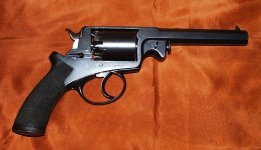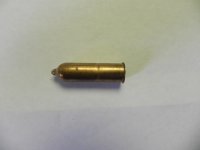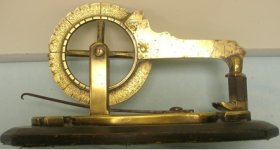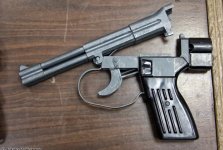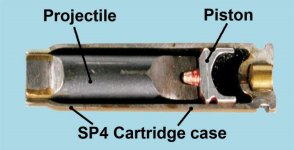You are using an out of date browser. It may not display this or other websites correctly.
You should upgrade or use an alternative browser.
You should upgrade or use an alternative browser.
What the heck
- Thread starter Ozzieman
- Start date
mapsjanhere
New member
PSS captive piston, Soviet Tula Arsenal, for SP4 ammo
doh, should have hit "reload", Scorch beat me
doh, should have hit "reload", Scorch beat me
Sorry about taking so long getting back on this one. Rebuilding my computer, nothing like replacing mother and graphics card and find out you need a MUCH higher wattage power supply.
So, Scorch you are correct and it's actually a very interesting gun. More information later today, I hope
So, Scorch you are correct and it's actually a very interesting gun. More information later today, I hope
200 PSS silent pistol
https://en.wikipedia.org/wiki/PSS_silent_pistol
Photo by Vitaly V. Kuzmin - Vitalykuzmin.net, CC BY-SA 4.0, https://commons.wikimedia.org/w/index.php?curid=18830892
The PSS silent pistol or MSS "VUL" (or "Wool" in English)[1] is the last completed weapon system resulting from the Soviet development of silent pistols operating on a sealed cartridge system. Two previous designs were considered unacceptable for use due to their limitation to two shots. Earlier systems included the MSP and SP-4M double barreled pistols. Developed around 1980, the PSS was first issued to KGB Spetsnaz in 1983. Intended for assassinations and reconnaissance, it is under production in the special weapons foundry at TsNIITochMash. PSS pistols are still in use by elite special forces units of many nations, as well as by some FSB, MVD.
Purpose[edit]
The PSS was developed to give Soviet special forces and secret police an almost completely silent option for covert operations such as reconnaissance and assassinations. The weapon uses a unique cartridge with an internal piston to achieve this end. Otherwise, it is a fairly simple double-action pistol. Few details are known about the pistol's performance, as only a few have entered western hands.[2]
Cartridge[edit]
The PSS uses a specially developed 7.62×42mm necked round SP-4 (СП-4), the same as used for the OTs-38 Stechkin silent revolver.[3] The cartridge contains an internal piston and a propelling charge, with the stem of the piston against the base of the bullet. On firing, the piston delivers enough impulse to project the bullet from the barrel to an effective range of 25 meters. The piston then seals the cartridge neck, preventing noise, smoke, or blast from escaping the barrel.[4]
Action[edit]
Due to a complete lack of a muzzle blast, the action of the PSS is best described as "Reaction action". Since no propellant gasses exit the cartridge casing after firing, rearward force is present only due to the projectile, and is used to cycle the pistol's slide. In all other respects, the PSS generally follows traditional conventions except for the slide's guide rod, which is located above the barrel and instead of guide rails on the pistol frame.
https://en.wikipedia.org/wiki/PSS_silent_pistol
Photo by Vitaly V. Kuzmin - Vitalykuzmin.net, CC BY-SA 4.0, https://commons.wikimedia.org/w/index.php?curid=18830892
The PSS silent pistol or MSS "VUL" (or "Wool" in English)[1] is the last completed weapon system resulting from the Soviet development of silent pistols operating on a sealed cartridge system. Two previous designs were considered unacceptable for use due to their limitation to two shots. Earlier systems included the MSP and SP-4M double barreled pistols. Developed around 1980, the PSS was first issued to KGB Spetsnaz in 1983. Intended for assassinations and reconnaissance, it is under production in the special weapons foundry at TsNIITochMash. PSS pistols are still in use by elite special forces units of many nations, as well as by some FSB, MVD.
Purpose[edit]
The PSS was developed to give Soviet special forces and secret police an almost completely silent option for covert operations such as reconnaissance and assassinations. The weapon uses a unique cartridge with an internal piston to achieve this end. Otherwise, it is a fairly simple double-action pistol. Few details are known about the pistol's performance, as only a few have entered western hands.[2]
Cartridge[edit]
The PSS uses a specially developed 7.62×42mm necked round SP-4 (СП-4), the same as used for the OTs-38 Stechkin silent revolver.[3] The cartridge contains an internal piston and a propelling charge, with the stem of the piston against the base of the bullet. On firing, the piston delivers enough impulse to project the bullet from the barrel to an effective range of 25 meters. The piston then seals the cartridge neck, preventing noise, smoke, or blast from escaping the barrel.[4]
Action[edit]
Due to a complete lack of a muzzle blast, the action of the PSS is best described as "Reaction action". Since no propellant gasses exit the cartridge casing after firing, rearward force is present only due to the projectile, and is used to cycle the pistol's slide. In all other respects, the PSS generally follows traditional conventions except for the slide's guide rod, which is located above the barrel and instead of guide rails on the pistol frame.
Mike Irwin
Staff
Not a Adams and Tranter, but close...
I THINK that's a Beaumont Adams British service revolver.
I THINK that's a Beaumont Adams British service revolver.
Mike you are correct sir.
And for those that care My computer is so fast now that I believe I have passed the Perception Horizon in speed.
My computer is so fast now that I believe I have passed the Perception Horizon in speed.
58 Beaumont–Adams revolver
https://en.wikipedia.org/wiki/Beaumont–Adams_revolver
The Beaumont–Adams revolver is a muzzle-loading, double-action, percussion revolver. Originally adopted by the British Army in .442 calibre (54-bore, 11.2mm) in 1856, many were later converted to use centrefire cartridges. It was replaced in British service in 1880 by the .476 calibre (actually 11.6mm)[1] Enfield Mk I revolver.
History[edit]
On 20 February 1856, Lieutenant Frederick E.B. Beaumont of the Royal Engineers was granted a British patent for improvements to the Adams revolver which allowed them to be cocked and fired either cocking the hammer as in Colt single-action revolvers, or by just pulling the trigger. It was the first true double-action system. Beaumont was granted a US Patent (no. 15,032[2]) on 3 June of the same year.
At that time there was intense competition between Adams and Colt, which was rapidly expanding its sales and had opened a London factory competing with the British firearms trade, manufacturing firearms with interchangeable parts. The older 1851 and 1854 Adams revolvers were self-cocking, also known as double-action. The Adams revolver was favoured by British officers in the Crimean War and colonial conflicts due to the stopping power of its larger 54 bore (.442 cal) bullet (compared with their main competitor, the smaller .36 cal Colt Navy revolvers), and the speed of the Adams trigger-cocking action for close-quarters fighting (over the more cumbersome Colt action).[3]
In partnership with George and John Deane, the company of Deane, Adams & Deane produced the new revolver in a variety of calibres and sizes, from pocket pistols to large military versions. The United Kingdom officially adopted the 54-bore (.442 calibre) Beaumont–Adams in 1856,[4] Holland and Russia following soon after. To meet the growing demand for its weapons, Deane, Adams & Deane contracted companies in Birmingham and Liége to manufacture their weapons under licence.[3] The new revolver gave Robert Adams a strong competitive advantage and Samuel Colt shut his London factory due to a drop in sales.
In the US, the Massachusetts Arms Company was licensed to manufacture about 19,000 specimens of the gun in .36 calibre, of which about 1,750 were purchased by the Union Army at the beginning of the American Civil War. They also made a pocket version in .32 calibre.
And for those that care
58 Beaumont–Adams revolver
https://en.wikipedia.org/wiki/Beaumont–Adams_revolver
The Beaumont–Adams revolver is a muzzle-loading, double-action, percussion revolver. Originally adopted by the British Army in .442 calibre (54-bore, 11.2mm) in 1856, many were later converted to use centrefire cartridges. It was replaced in British service in 1880 by the .476 calibre (actually 11.6mm)[1] Enfield Mk I revolver.
History[edit]
On 20 February 1856, Lieutenant Frederick E.B. Beaumont of the Royal Engineers was granted a British patent for improvements to the Adams revolver which allowed them to be cocked and fired either cocking the hammer as in Colt single-action revolvers, or by just pulling the trigger. It was the first true double-action system. Beaumont was granted a US Patent (no. 15,032[2]) on 3 June of the same year.
At that time there was intense competition between Adams and Colt, which was rapidly expanding its sales and had opened a London factory competing with the British firearms trade, manufacturing firearms with interchangeable parts. The older 1851 and 1854 Adams revolvers were self-cocking, also known as double-action. The Adams revolver was favoured by British officers in the Crimean War and colonial conflicts due to the stopping power of its larger 54 bore (.442 cal) bullet (compared with their main competitor, the smaller .36 cal Colt Navy revolvers), and the speed of the Adams trigger-cocking action for close-quarters fighting (over the more cumbersome Colt action).[3]
In partnership with George and John Deane, the company of Deane, Adams & Deane produced the new revolver in a variety of calibres and sizes, from pocket pistols to large military versions. The United Kingdom officially adopted the 54-bore (.442 calibre) Beaumont–Adams in 1856,[4] Holland and Russia following soon after. To meet the growing demand for its weapons, Deane, Adams & Deane contracted companies in Birmingham and Liége to manufacture their weapons under licence.[3] The new revolver gave Robert Adams a strong competitive advantage and Samuel Colt shut his London factory due to a drop in sales.
In the US, the Massachusetts Arms Company was licensed to manufacture about 19,000 specimens of the gun in .36 calibre, of which about 1,750 were purchased by the Union Army at the beginning of the American Civil War. They also made a pocket version in .32 calibre.
FYI
https://www.bing.com/videos/search?...5E711264860D7F09C9795E711264860D7&FORM=VRDGAR
It was a powder tester that started this off and I found a video of one being used. It does seem match 3 GR to the gage reading more than 2.5. Sorry its not in english
https://www.bing.com/videos/search?...5E711264860D7F09C9795E711264860D7&FORM=VRDGAR
It was a powder tester that started this off and I found a video of one being used. It does seem match 3 GR to the gage reading more than 2.5. Sorry its not in english
sgms You are so close to the name I'm going to give you that one for a win.
Attached are a couple of attached web addresses for videos on the gun. I found it very interesting.
I had never heard of the teat fire cartridge and only found it by looking at guns and saw that one had the cut in the cylinder for the rim of the case at the front of the cylinder.
201 Teat-fire cartridge
https://en.wikipedia.org/wiki/Teat-fire_cartridge
http://peashooter85.tumblr.com/post/32704767151/the-teat-fire-cartridge-and-revolver-around-the
https://www.bing.com/videos/search?...52EC572CA1FA9E2586CA52EC572CA1FA9&FORM=VRDGAR
The Teat-fire cartridge was a .32 caliber pistol cartridge designed by Daniel Moore and manufactured by Moore and his partner David Williamson for their Pocket Revolver, was produced under both the Moore and National Arms marques by the National Arms Company of Brooklyn, New York in the mid-19th century.
The Moore Caliber .32 Teat-fire, which used a unique cartridge to get around the Rollin White patent owned by Horace Smith and Daniel Wesson, proved very popular during the Civil War, with both soldiers and civilians. The "Teat-fire" cartridges did not have a rim at the back like conventional cartridges, but were rounded at the rear, with a small "teat" that would protrude through a tiny opening in the rear of the cylinder. The priming mixture was contained in the "teat" and when the hammer struck it, the cartridge would fire. Thus, it was akin to a rimfire cartridge, but instead of having priming all the way around the edge of the rim, it is centrally located in the teat.[1]
Moore's Caliber .32 Teat-fire Pocket Revolver proved very popular during the American Civil War, with both soldiers and civilians. National Arms produced about 30,000 of the revolvers from 1864 to 1870, when it was acquired by Colt's Manufacturing Company.[2]
Attached are a couple of attached web addresses for videos on the gun. I found it very interesting.
I had never heard of the teat fire cartridge and only found it by looking at guns and saw that one had the cut in the cylinder for the rim of the case at the front of the cylinder.
201 Teat-fire cartridge
https://en.wikipedia.org/wiki/Teat-fire_cartridge
http://peashooter85.tumblr.com/post/32704767151/the-teat-fire-cartridge-and-revolver-around-the
https://www.bing.com/videos/search?...52EC572CA1FA9E2586CA52EC572CA1FA9&FORM=VRDGAR
The Teat-fire cartridge was a .32 caliber pistol cartridge designed by Daniel Moore and manufactured by Moore and his partner David Williamson for their Pocket Revolver, was produced under both the Moore and National Arms marques by the National Arms Company of Brooklyn, New York in the mid-19th century.
The Moore Caliber .32 Teat-fire, which used a unique cartridge to get around the Rollin White patent owned by Horace Smith and Daniel Wesson, proved very popular during the Civil War, with both soldiers and civilians. The "Teat-fire" cartridges did not have a rim at the back like conventional cartridges, but were rounded at the rear, with a small "teat" that would protrude through a tiny opening in the rear of the cylinder. The priming mixture was contained in the "teat" and when the hammer struck it, the cartridge would fire. Thus, it was akin to a rimfire cartridge, but instead of having priming all the way around the edge of the rim, it is centrally located in the teat.[1]
Moore's Caliber .32 Teat-fire Pocket Revolver proved very popular during the American Civil War, with both soldiers and civilians. National Arms produced about 30,000 of the revolvers from 1864 to 1870, when it was acquired by Colt's Manufacturing Company.[2]
FYI
The Russian silent pistol required some more research and I found more info you might find interesting.
I wondered how they made a silent gun, in fact it's amazing. The case contains the pressure of the propellant after the "bullet" has left the gun. In fact the fired cases can be dangerous for several weeks if some nitwit tried to take them apart.
http://www.sadefensejournal.com/wp/?p=1812
The Russian silent pistol required some more research and I found more info you might find interesting.
I wondered how they made a silent gun, in fact it's amazing. The case contains the pressure of the propellant after the "bullet" has left the gun. In fact the fired cases can be dangerous for several weeks if some nitwit tried to take them apart.
http://www.sadefensejournal.com/wp/?p=1812
Attachments
Scorch you are correct sir.
199 SPP-1 underwater pistol
https://en.wikipedia.org/wiki/SPP-1_underwater_pistol
The SPP-1 Underwater Pistol was made in the Soviet Union for use underwater by Soviet frogmen as an underwater firearm.[2] It was developed in the late 1960s and accepted for use in 1971. Underwater, ordinary-shaped bullets are inaccurate and very short-range. As a result, this pistol fires a round-based 4.5 millimetres (0.18 in) caliber steel dart about 115 millimetres (4.5 in) long, weighing 12.8 grams (0.45 oz), which has longer range and more penetrating power than speargun spears. The complete cartridge is 145 millimetres (5.7 in) long and weighs 17.5 grams (0.62 oz).[6]
Design[edit]
The SPP-1 has four barrels, each containing one cartridge. Its ammunition comes as a magazine of four cartridges which is inserted into the pistol's breech.[5]
Its barrel is not rifled; the fired projectile is kept in line by hydrodynamic effects. As a result, it is somewhat inaccurate when fired out of water.[1]
A double-action firing mechanism fires one cartridge sequentially for each pull of the trigger. When all four cartridges are spent, the gun can be reloaded above or below water.[2]
The SPP-1M pistol is essentially the same as the SPP-1, with the following differences:[5]
• It has an extra spring above the sear to improve the trigger pull.
• Its trigger guard is larger to accommodate diving gloves.
The weapon was designed by Vladimir Simonov, the cartridge by Pyotr Sazonov and Oleg Kravchenko.[1] Simonov also designed the APS amphibious rifle.[7]
Performance[edit]
Depth reduces range because the higher pressure closes the cavity sooner. Once the projectile is no longer supercavitating, hydrodynamic drag increases greatly, and the projectile becomes unstable.
Lethal range is defined as the range from which it can easily penetrate a padded underwater suit or a 5 millimetres (0.20 in) thick glass faceplate.[4]
It is manufactured by TOZ (Tulsky Oruzheiny Zavod/ Тульский Оружейный Завод) Tula Arms Plant,[3] and exported by Rosoboronexport,[2] the state agency for Russia's export/import of defense-related products.
199 SPP-1 underwater pistol
https://en.wikipedia.org/wiki/SPP-1_underwater_pistol
The SPP-1 Underwater Pistol was made in the Soviet Union for use underwater by Soviet frogmen as an underwater firearm.[2] It was developed in the late 1960s and accepted for use in 1971. Underwater, ordinary-shaped bullets are inaccurate and very short-range. As a result, this pistol fires a round-based 4.5 millimetres (0.18 in) caliber steel dart about 115 millimetres (4.5 in) long, weighing 12.8 grams (0.45 oz), which has longer range and more penetrating power than speargun spears. The complete cartridge is 145 millimetres (5.7 in) long and weighs 17.5 grams (0.62 oz).[6]
Design[edit]
The SPP-1 has four barrels, each containing one cartridge. Its ammunition comes as a magazine of four cartridges which is inserted into the pistol's breech.[5]
Its barrel is not rifled; the fired projectile is kept in line by hydrodynamic effects. As a result, it is somewhat inaccurate when fired out of water.[1]
A double-action firing mechanism fires one cartridge sequentially for each pull of the trigger. When all four cartridges are spent, the gun can be reloaded above or below water.[2]
The SPP-1M pistol is essentially the same as the SPP-1, with the following differences:[5]
• It has an extra spring above the sear to improve the trigger pull.
• Its trigger guard is larger to accommodate diving gloves.
The weapon was designed by Vladimir Simonov, the cartridge by Pyotr Sazonov and Oleg Kravchenko.[1] Simonov also designed the APS amphibious rifle.[7]
Performance[edit]
Depth reduces range because the higher pressure closes the cavity sooner. Once the projectile is no longer supercavitating, hydrodynamic drag increases greatly, and the projectile becomes unstable.
Lethal range is defined as the range from which it can easily penetrate a padded underwater suit or a 5 millimetres (0.20 in) thick glass faceplate.[4]
It is manufactured by TOZ (Tulsky Oruzheiny Zavod/ Тульский Оружейный Завод) Tula Arms Plant,[3] and exported by Rosoboronexport,[2] the state agency for Russia's export/import of defense-related products.

